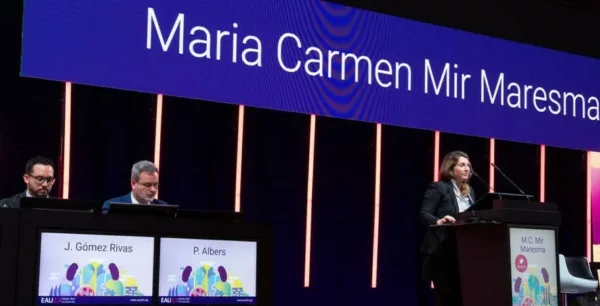Best of EAU23: Excerpts from the congress’s most crucial updates
Europe’s biggest urological event of the year, the 38th Annual EAU Congress (EAU23), concluded with a special session that encapsulated EAU23’s key takeaways.

Moderated by Scientific Congress Office Chair Prof. Peter Albers (DE) and Young Academic Urologists Chair Dr. Juan Gómez Rivas (ES), the session “Best of EAU23: Take-home messages” disseminated crucial research and technological updates. Read on for some of the notable developments unveiled during the congress.
Prostate cancer (PCa)
Liquid biopsy
Prof. Arnauld Villers (FR) cited the findings of the abstract A0370: The role of circulating tumour cell-based PSMA mRNA in localized or locally advanced prostate cancer. The paper evaluated whether circulating tumour cells (CTC)-based prostatic specific membrane antigen (PSMA) messenger RNA (mRNA) or PSA mRNA alone can predict biochemical recurrence (BCR) after radical prostatectomy (RP) in localised PCa. The paper stated that quantified PSMA gene expression in CTC can be used as a useful marker to predict BCR after RP. The CTC count and detection rate of PSMA mRNA expression increased for more advanced PCa.
Early detection of PCa
Prof. Villers said that back in September 2022 during a session on the impact of the European Commission recommendations, Prof. Hein Van Poppel (BE) stated that organised risk-adapted screening for PCa is almost unstoppable at this point. This year at EAU23, Ms. Renée Hogenhout (NL) said that the best method of risk-stratification before biopsy is now well settled. She emphasised that it is important to break the link between prostate-specific antigen (PSA) and immediate biopsies. Harmonised screening pathway is the key issue for EU member states.
In addition, Prof. Villers also discussed abstract A0894: Population-based organised prostate cancer testing: Outcomes of the first 999 men – a pilot project. The paper reported that organised PCa Testing Program (OPT) is on its way for the majority of 22 regions of Sweden in 2023. In this series, including three regions, 999 men in age groups 50 y (n=367), 56y (n=307) and 62y (n=305) were invited. The risk-stratification based on PSA, PSA density (PSAD) and magnetic resonance imaging (MRI) according to the Prostate Imaging and Reporting and Data System (PI-RADS). No biopsy indication if PIRADS ≤ 3 and PSAD < 0.15%. About 8% of the men had PSA > 3 ng/ml and 1% had clinically significantly PCa.
Paediatric urology
Urachal remnants
Prof. Selçuk Silay (TR) presented one of the updates of the EAU Guidelines on Paediatric Urology concerning urachal remnants. The latter appear to be more common than previously reported. During the first six to 12 months, it was observed that spontaneous resolution is common. The excision of symptomatic urachal anomalies is effective and safe with minimal morbidity.
Robot-assisted laparoscopic extra-vesical ureteral reimplantation (RALUR)
Prof. Silay also shared the key messages of the paper “Robot-assisted laparoscopic extra-vesical ureteral reimplantation (RALUR/REVUR) for paediatric vesicoureteral reflux: A Systematic Review of Literature” which included the advantages of open ureteral reimplantation: shorter operating time, lower costs, and the established procedure is the gold standard. Furthermore, for the robotic surgery, it has shorter duration of admission and catheterisation with less postoperative pain. These mean a higher quality of life (QoL) can be defined for the children.
Bladder cancer (BCa)
Prof. Joost Boormans (NL) provided the BCa updates which included the key takeaways from the abstract A0547: Carboplatin induction chemotherapy in clinically lymph node-positive bladder cancer. Cisplatin-based induction chemotherapy (IC) seems superior to gemcitabine/carboplatin and should be the standard for cisplatin-eligible clinically positive lymph nodes (cN+) BCa patients. Gemcitabine/carboplatin may be an alternative treatment in selected cisplatin-ineligible cN+, especially in cN1 patients.
In addition, he cited core messages of various abstracts such as:
- Patient-derived organoids of all BCa stages recapitulate primary tumours. (A1167: Patient-derived organoids as a promising preclinical model for assessing therapy response in bladder cancer)
- Pre- and post-chemotherapy proteomic profiling of muscle-invasive bladder cancer (MIBC) reveal the important mechanisms of chemoresistance. (A1163: Proteomic profiling of muscle invasive bladder cancer treated with neoadjuvant chemotherapy)
Renal cancer
Dr. Maria Carmen Mir-Maresma (ES) delivered the crucial updates of the lectures on renal cancer, one of which was from the OPERa Study (a Multicenter Observational Prospective Cohort Study to Evaluate Determinants of Long-Term Quality of Life Following Restorative Proctectomy for Rectal Cancer Treatment) which compared robotic assisted partial nephrectomy (RAPN) and open partial nephrectomy (OPN) in intermediate/high complexity renal tumours. With RAPN, there is numerically a lower 30-day complication rate (primary endpoint). With regarding to oncologic and functional outcomes, there was no difference.
She also provided findings of the abstract A0469: Renal parenchymal infiltration or micronodular spread in non-metastatic clear cell renal cell carcinoma: Prognostic impact and genomic backgrounds. The results showed that if a biopsy-all strategy is implemented, the expected rate of surgeries upfront is avoided. The study concluded that non-selective use RB (angiomyolipoma or cystic mass) in patients with renal mass avoids a significant number of surgeries up front, a marginal but existing number of complications and is associated with decreased healthcare expenditures.
Benign prostatic hyperplasia
Prof. Jean-Nicolas Cornu’s presentation included a comparison between robot-assisted simple prostatectomy (RASP) and the holmium laser enucleation of the prostate (HoLEP) procedure based on the paper “Robot-Assisted Simple Prostatectomy versus Holmium Laser Enucleation for the Treatment of benign prostatic hyperplasia in large (>100 ml) prostates: updated comparative analysis from a high-volume centre” by Prof. Alex Mottrie (BE). The baseline characteristics among patients receiving either did not differ. Patients treated with RASP had higher comprehensive complication index (CCI) scores and bigger prostates at preoperative imaging. The RASP median operative time, catheterization time and length of stay were slightly shorter in the HoLEP group. Transitory urge incontinence rates were higher in the HoLEP group.
Prof. Cornu also shared key points of the study “Transperineal Laser Ablation vs Transurethral Resection for Benign Prostatic Obstruction: A Randomised Clinical Trial” (Bertolo et al, NCT04781049). The study’s primary endpoint was change in ejaculatory function assessed by the Ej-MSHQ (ejaculatory domain-male sexual-health inventory) at one month after surgery. The secondary endpoints included comparison of perioperative pain were measured by visual analogue scale (VAS); and the changes in sexual function were measured by International Index of Erectile Function (IIEF-5), international prostate symptom score (IPSS), QoL, and maximum flow rate (Qmax) at one to six months as appropriate.
Functional urology
Prof. John Heesakkers (NL) shared insights from the paper “Adopting machine vision augmentation to detect detrusor instability in OAB: A frontier of AI application in functional urology” (Woo, et al). Machine learning vision software can identify micro-contractions based on blood vessel networks to reliably correlate with overactive bladder (OAB) diagnosed on urodynamic studies (UDS).
The process involves conversion of raw cystoscopy videos to images. Then the bubbles, areas of bleeding and dead pixels are corrected. De-noising is done using Deep Learning models. The Super Resolution enhances vessel network for analysis. Then blood vessel network undergoes U-Net segmentation, which allows for formation of key points in the vascular network. The movements of key points are tracked over time. Then the heat map of relative movement is generated. The degree of key point movement can be useful in predicting OAB. The motion differences can be tracked both quantitatively (number of key points) and qualitatively (extent of displacement of key points over time).
Imaging
Bladder cancer
One of the key research results that Dr. Jochen Walz (FR) provided was from the abstract A0599: Can we avoid second transurethral resection according to VI-RADS score in patients with high-risk non-muscle-invasive bladder cancer? wherein the aim was to evaluate VI-RADS score for high-risk NMIBC to exclude the need of re-TURB. The results showed that avoiding second TUR based on VI-RADS scores may lead to underdiagnosis and insufficient treatment.
PCa
Abstract A0970: Global variation in the quality of multiparametric Magnetic Resonance Imaging of the prostate from the PRIMEtrial (the GLIMPSE study) aimed to evaluate the global variation in prostate multiparametric MRI (mpMRI) quality and determine whether basic modifications to MRI protocols could optimise diagnostic quality. The conclusion was that initial MRI quality was fair, with room for improvement, particularly with Dynamic Contrast Enhanced (DCE) imaging. With very basic changes in line with PI-RADS recommendations, global MRI quality can be easily improved.
Stones
Micro CT imaging
Prof. Thomas Knoll (DE) presented important updates on micro computed tomography (CT) imaging to predict Randall plaque progression. The study involved 36 kidney specimens from nephrectomy. What the study demonstrated was that the papillary changes occurred before formation of the Randall plaques with correlation to oxaluria, calciuria and uricosuria. The question is there a threshold for treatment of metabolic abnormalities?
Holmium:yttrium-aluminium-garnet (Ho:YAG) vs. thulium fiber laser (TFL)
Prof. Knoll also discussed the differences between and when to use Ho:YAG and TFL. Ho:YaG should be used when there are impacted ureteral stones, large renal stones, and stones that are hard to reach. It can be used as a dilated collecting system (pop-dusting), ureteral access sheath, and for high-flow irrigation. Ho:YAG can be used in contact and non-contact lithotripsy.
TFL, on the other hand, can only be used in contact lithotripsy. TFL should be used when dusting small renal stones (150µm fibre), there is no access sheath, and there is low-flow irrigation. TFL should be used in low-power settings (10 to 14W), for endoscopic papillotomy, and planned stentless ureteroscopy.
Andrology
Dr. Maarten Albersen (BE) shared the findings of the study “Klinefelter syndrome testicular organoids: Androgen production and spermatogonia differentiation in vitro” by G. Galdon, et al. KS is the most common genetic cause of male infertility; 1 out of every 650 males are born with KS where 90% of whom will present azoospermia in adulthood. KS is severely underdiagnosed.
From tissue donated by KS patients, testicular organoids were cultured in media to recreate postpubertal testicular conditions. The results showed that KS testicular organoids remained viable, producing ATP and testosterone for 21 days. Haploid cells were identified inside the organoid after 21 days of differentiation. The detection of haploid cells in organoid culture of KS patients is promising. Although still preliminary, the technology may open up new avenues of fatherhood for patients suffering from KS.
Testis and penile cancer
Prof. Albersen proceeded with crucial updates concerning penile cancer. He disclosed the research results of the paper “Penile cancer care in the Netherlands over three decades: Increased incidence, centralisation of care, and overall survival” (Vreeburg, et al). The study showed the beneficial effect of centralised healthcare in penile cancer with a 30% overall survival benefit despite patients presenting with higher disease burden.
Prof. Albersen also discussed the paper “Need for organ preservation in postchemotherapy retroperitoneal lymph node dissection (PC-RPLND)” by Nestler, et al. This study showed a tremendous need for more organ preservation as 40% of all resections of adjunct organs are oncologically unnecessary due to the presence of necrosis/fibrosis (N) only in pathological specimens. Frozen section analysis should be explored more, serological or image-based biomarkers for N are needed.
You can view the full Special Session Best of EAU23: Take-home messages via the EAU23 Resource Centre.


